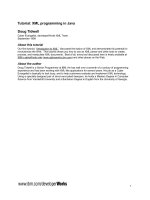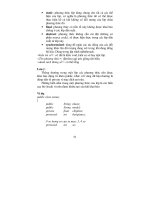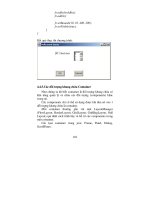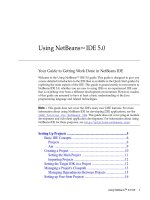Java beans
Bạn đang xem bản rút gọn của tài liệu. Xem và tải ngay bản đầy đủ của tài liệu tại đây (176.9 KB, 27 trang )
and VSAM. The Java Web Server is a Web server in its own right, meaning that the
ability to access static documents is definitely not lost. However, with a little
additional work, you can create executable content for your Web pages and begin to
truly harness the power of the Internet by making it a place where applications are run,
not simply downloaded.
Chapter 8. Java Beans
•
Component Models
•
Overview of the Java Beans Component Model
•
Java Beans
•
Making a Bean
•
Using Java Beans
•
Server-Side Java Beans
•
Enterprise Java Beans
•
COM/DCOM and ActiveX
Java Beans, Microsoft COM/ActiveX, and the newly announced CORBA Component
Model support the notion of an application component model. A component model
enables software parts from several different programmers to work together. In the
Internet world, we refer to everything from Java applets to parts that directly interface
to databases or desktop applications as components that we can reuse. By developing
reusable components, you can preserve the effort you place into software
development by packaging them in modules that you can publish to others.
A Bean is a class that follows a specific naming convention for its methods, can
handle its own persistence, and is packaged in a way that makes it easy to distribute
and use. By placing our componentized Beans in one place, with a well-defined
interface, we can easily assemble applications by picking our components and wiring
(connecting) them together using events and some additional Java code as glue. This
is the same way that digital engineers build hardware systems; logic chips are
componentized into families by technology type (TTL, CMOS, ECL,…). As long as
we stay within a logic family, assembling a system is like programming in hardware.
If we understand the function(s) to be provided and understand the functions provided
by our components, designing and building a system is reduced (maybe simplistically)
to plugging everything together in the right order. Of course, we have to worry about
"timing" and "leading and trailing edge triggers," but it's not much different than
worrying about things like "pass by value," "pass by reference," and "side effects."
Java Beans technology is currently in wide use both in client- and server-side
applications. Whether you realize it or not the Abstract Windowing Toolkit (AWT)
and Swing components (a la JDK 1.2) we use for building user interfaces for our
applications are implemented as Beans. A Java component industry, like the after
market VBX/OCX component industry created by the popularity of Microsoft's
Visual Basic, has begun to spring up and, while slow in coming, will blossom as more
and more enterprise business moves to the Enterprise Java Beans component model.
Component Models
As an example of a component-based system, think of your home entertainment
center. It consists of a number of components (pieces) each having a well-published
interface that has been agreed upon by the manufacturers in the home entertainment
industry. Each component has a set of properties and controls that govern the way
each operates. In much the same manner, Beans are software components with
properties and methods (controls) that govern the way they work. Beans also have a
well-published interface for interaction by means of the Java event model (see Figure
8-1).
Figure 8-1. Your home entertainment center is composed of several different
components.
Component models are not necessarily examples of network programming. Instead,
component models provide a means to assemble several networked components under
one umbrella. One of the components in a large application may be a network
component in charge of talking to remote objects. When you group it with other non-
networked objects, that one component makes all of the components networked.
The Competition
Sun's Java Beans and Microsoft's Component Object Model and Distributed
Component Object Model (COM/DCOM) are component models competing for what
they feel is their fair share of the Internet. Today, the Abstract Window Toolkit and
Swing classes provide a static component model that promotes interaction between
components within the same applet or application. It does not address the issue of
many kinds of Internet parts within the same page. Instead, it defines interaction
between components within an applet or application.
In this chapter, we focus on the Java Beans component model and will spend a little
time looking at COM/DCOM. As the owner and progenitor of the Java language, Sun
Microsystems has a competitive edge over Microsoft in the Internet arena. Even
though Microsoft will continue to dominate the desktop, new Java technology will
emerge the fastest and the most reliably from Sun and its partners.
Overview of the Java Beans Component Model
In conceptual terms, a component model is a definition of how different parts interact
with one another within one granular space. Translating the big picture definition into
Java APIs is a more difficult task. A component model becomes both an overall
architectural plan as well as a set of individual APIs that enable programmers to
realize the vision.
Every component, referred to as a Bean, should provide each of five services designed
to promote interaction between Beans:
1. Interface Publishing
2. Event Handling
3. Persistence
4. Layout
5. Builder Support
At its simplest, Java Beans is a set of naming conventions, a method for packaging a
Bean and the simple requirement that a Bean handle its own persistence.
Interface Publishing
In order to enable one Bean to make another Bean do something, the Beans must have
a published set of methods that follow a simple naming convention and a published
set of events that are generated. The naming convention is straightforward; if a
method is to allow the setting of an attribute, then it must start with the characters
"set"; if it is to be used to retrieve the value of an attribute, it should start with the
characters "get". For example:
class Simple Bean implements Serializable{
private String myName; // attribute
public String getName(){
return myName; }
public void setName(String n){
myName = n; }
}
When several Beans join together, they form a Java Beans application. In order for a
Bean application to function properly, its constituent Beans must be able to
communicate with one another.
The component Beans must publish their interfaces to the container Bean application
so that any Bean within the application can acquire a reference to a component. Other
components may then invoke the Bean and use it as it was intended. For example, if
we were to create a Java Beans application to catalog all our toys, we would create
several individual Beans and then link them together. One of the Beans may talk to a
database that keeps track of our toys; another Bean may display and handle a user
interface. In order for the user interface Bean to get to the database, it must use the
database Bean. The database Bean must publish an interface to itself in order for it to
be used.
Event Handling
In the AWT, you can create a user interface with a button and a text area. When the
button generates an event, it can trigger a event in the text area. The end result is that
the event is handled and passed on to another object.
Similarly, Beans must be able to pass events to one another. Java Beans applications
need not be unified under one user interface. In fact, a Java Beans application may
have several different applets contained within it, all of which have their own user
interface. When something happens in one applet, the other applets may want to know.
In our toy catalog example, we want to have two different applets. One applet lists
every toy; the other displays a picture of each toy. If you select "Buzz Lightyear
Action Figure" from the list, the list sends a message to the
display
Bean to show a
picture of the toy. We can model our Java Beans application to use each applet and
unify them.
In much the same way, Bean components can be made to talk to one another and
trigger events in each other. The powerful component model on top of which Java
Beans was developed promotes the idea of object separation. Remember that you are
really creating separate objects that could exist in their own right without a Beans
container. The fact that you are combining each of these separate components under
one roof says a great deal about the highly object-oriented nature of the Java language.
Persistence
As we discussed in the Chapter 1 section on object serialization, persistence of objects
is a very important topic. Persistence moves us from a session-based paradigm in
which objects are started, exist for a little while, and then disappear, to a lifecycle-
based paradigm in which objects are started and exist for a little while. This time,
however, instead of the object disappearing off the face of the earth, it is saved,
restored, and allowed to exist again. Java Beans supports persistence primarily
through object serialization. You may, however, attach a JDBC or JNDI application to
your Bean and store your Bean in a relational database or directory server. Java Beans
will let you handle your own persistence if you choose not to take advantage of its
own brand of object storage. Even if you choose to do this, it is still an interface and
you need to follow the get/set naming convention for methods.
Layout
Earlier we spoke of Java Beans applications whose components each have their own
distinct user interfaces. The Beans framework provides a set of routines to lay out the
various parts effectively so that they don't step on one another. The layout
mechanisms also allow the sharing of resources. Let's say your two different user
interfaces both used a fancy picture button. You could share the picture button class
across each component, saving download time and improving the efficiency of your
application. Java Beans applications assist a great deal in improving the performance
of large applications.
The Java Beans layout mechanisms allow you to position your Beans in rectangular
areas. The programmer is left to decide whether the regions overlap or maintain a
discrete layout space. Beans makes no effort to provide a complex layout manager,
choosing instead to implement the standard Java managers.
Builder Support
One other area in which you might want to invest significant design time is builder
support. Builders are applications that allow the creation of user applications by
selecting various Beans and graphically connecting them together by their events.
Most notably, builders take the form of GUI builders such as Visual Cafe, JBuilder,
J++, and Visual Age for Java. Chances are that other programmers who desire to take
advantage of your hard work could reuse your Bean. Packaging your Beans in such a
way that GUI builder applications can access them may be beneficial to you.
A GUI builder could obtain a catalog of methods used by your Bean application, as
well as the proper means to access each individual Bean. That way, the builder can
graphically represent the Beans application and provide connections into the
application from outside. The end result is that your Bean application could be used
by another application.
Distributed Beans
Because Beans are written in Java, they are fully portable and can take complete
advantage of the write-once-run-anywhere principle. Furthermore, Java Beans ensures
that no matter how small your constituent components, it will not in any way
overburden them. This allows full distribution of applets and applications wrapped in
Java Beans containers. You will not have to make trade-off decisions on whether or
not to use Beans, and you will have complete freedom to use Java Beans.
Java Beans also does not interfere with the communication mechanisms we described
earlier in this book. It exists peacefully alongside both Java IDL and Java RMI. Just
because your applications want to communicate with the network does not mean that
Java Beans is off limits to you.
Why Use Beans?
If you've ever tried to create a series of applications on a single Web page, no doubt
you've discovered the limitations of the applets themselves. Your applets cannot
communicate with one another, and an event in one cannot trigger an event in another.
Java Beans proposes a solution to that limitation. Beans, at its essence, is nothing
more than a giant Tupperware container for applets and applications. By sticking all
your applets within the same container, you can effectively have them communicate
freely, so long as they do not leave the container.
But, Beans adds several more capabilities than does a simple container class, many of
which we've discussed in this section. Java Beans is Java; Java Beans is easy; Java
Beans is fun. Most importantly, however, Java Beans is a flexible way to group Java
applets and applications under a unified umbrella.
Java Beans
Java Beans provides a lot of functionality for a low price. When you use the Java-
endorsed component model, you are ensured a language-compliant implementation
that does nothing to violate the spirit of the Java language. The same security model,
application interaction model, and event model are used throughout Java Beans.
In fact, the creators of Beans intended their component model to be an extension to
the process of learning the language itself. They didn't want anything to be too hard,
or too ineffective. Often, sacrificing ease of use for functionality leads projects to
failure. However, the opposite is also true. Making a project so easy to use will often
leave it devoid of any usefulness. Java Beans avoids both pitfalls and provides a more
than adequate middle ground.
Component Interaction
As you can see in Figure 8-2, a given Java Bean supports three levels of interaction.
Each Bean exhibits certain properties, can be invoked by several methods, and can, in
turn, trigger events in other Beans. This component interaction model lends Beans its
great flexibility. Simply by publishing the APIs for itself, a given Bean can tell every
other Bean about its properties and methods and trigger events based on other
published APIs and invocations on its own method library.
Figure 8-2. Each Java Bean supports three interaction levels:properties, methods, and
events.
Properties are discussed in detail a bit later, but they are essentially the internal
representation of a Bean. Imagine that you have a vase filled with an assortment of
flowers. In this instance, the vase is the Bean; it can hold a certain amount of water
based on its size, but it can also hold a maximum number of flowers, based on the size
of the throat of the vase. Properties are the basic things about an object that describe it
at some point in time, its state variables.
Methods are those things that can be done to a Bean. Can you add flowers or remove
flowers from a vase? Can your vase also be filled with water? In that case, water is a
property, and filling with water is a method, or something that is done to one of the
properties.
Let's say your flowers give off a wonderful scent that everyone appreciates. These are
events triggered by the vase and pushed out to the rest of the Beans within the same
component model.
Network Communication
A key element of effective distributed design is deciding where to split the local
computation and the remote computation. When we created the Internet Calendar
Manager discussed in the previous chapters, we had to determine where we were
going to split the local processing of appointments from the remote storage of the
appointments. We decided to create the Network module that would handle that
situation for us. The module receives raw data from the network and translates it into
usable data structures for the rest of the application (see Figure 8-3).
Figure 8-3. A set of Beans can use a network Bean to connect to the network.
We recommend that Java Beans be used in much the same way for networked
communication. Create a Bean whose sole purpose is to funnel information to and
from remote processes. With this kind of modular design, your Bean can act as a go-
between to network resources, saving precious computation cycles.
As of now, the Java Bean product road map calls for Java IDL, Java RMI, and JDBC
support. Further revisions of the Beans specification will implement other network
mechanisms as they are created.
User Interface Issues
Java Beans was designed with the idea that Beans can be integrated very easily into
GUI builders. GUI builders need access to each component that they play with, so the
Beans APIs were designed accordingly. Every standard Bean supports the notion of
introspection. Each Bean can be looked into, in much the same way we could look
into a window (see Figure 8-4
). We don't see the whole picture, and we certainly don't
see what exactly is going on, but we can see a snapshot of what is possible.
Introspection enables us to see the APIs for a given Bean, and more importantly, for
an application builder of some kind to plug into the Bean and hook other components
to it.
Figure 8-4. The notion of introspection supported by each standared Bean enables GUI
builders to see inside the Bean and access components needed.
Introspection services come in two types: low level and high level. Low-level
introspection allows trusted applications, like GUI builder programs, a very low level
of access to a Bean's internals because that is what is needed to be able to hook Beans
up to one another. The higher level introspection is provided for application
interfacing and only provides information about public properties, methods, and
events.
TIP
Java Beans also supports Uniform Data Transfer (UDT) between components. The
UDT mechanism alluded to in the Beans specification declares that data can be
transferred between Beans in a variety of easy-to-implement ways. Choosing
between drag-and-drop, cut-and-paste, keyboard, and other methods is a matter of
Bean implementation.
Java Beans also supports the notion of GUI merging. In GUI merging, child Beans
can pass their user interface properties up the hierarchy tree to their parent. In so
doing, the parent Bean can set up a consistent look and feel for a GUI, and child
Beans can add components to the GUI. The classic example is a menu bar. The parent
Bean provides the general appearance of the bar. Child Beans then add entries to the
bar (File, Edit, View, and so forth). This way, the child Bean has total and complete
control over what a GUI is, whereas the parent sets a general policy for what it will
look like.
Persistence
Beans should also be able to save their internal properties between invocations. For
example, if we were to instantiate a Bean, change its state, and then shut the Bean
down, in some instances we'd want the data we changed to return when the Bean is
started up again. This is referred to as a persistent state; in other words, the values are
not reinitialized every time.
TIP
Persistence can be implemented in several ways, but in the end you have the
choice between automatic, Bean-provided persistence and self-managed
persistence. When you manage your own persistence, more than likely you will
want to do so using the network. Your Bean can store its internal properties on a
remote database, and you can access and store the changes using JDBC. Or you
may want to use RMI or IDL to handle your storage techniques.
Events
Java Beans provides an AWT-friendly event notification mechanism. If an event is
triggered in your Bean, you should be able to pass that event on to other Beans in your
component model. Sometimes events will come in over a network. In these cases, you
should handle them as if they were coming from a local Bean.
Properties
Because Beans are nothing more than Java classes, you can create whatever member
variables you desire. Furthermore, Beans can contain other Beans within them. In our
earlier vase of flowers example, our vase Bean could very easily be contained within a
"living room" Bean, which could be contained within a "house" Bean, which could be
contained within…, well, you get the picture.
Beans in a Nutshell
Beans enable you to harness the power of object-oriented programming and take it to
a new level. Instead of publishing libraries of classes, you can now publish entire
objects that can be used, abused, imported, delegated, or whatever else you choose to
do with them. Beans could just as easily be applications in their own right, but instead
are there to help you.
This book only glosses the surface of what Beans can do for you. Trust us, there will
be much, much more written on this fascinating and exciting topic. To whet your
appetite, however, let's create a simple Bean that models our National Pastime.
Making a Bean
Making a Bean is relatively straightforward. We need to make sure that the Bean
implements the serializable interface and that we follow the Java Beans naming
convention for the Bean's getter and setter methods. Getters and setters are the Bean
methods that are provided to get and set the values of the Bean's properties. The
naming convention is simple and requires that setter methods are named starting with
the characters "set" (e.g., setVolume, setHeight) and that getter methods start off with
the characters "get" (e.g., getVolume, getHeight). By using these prefixs for our getter
and setter functions, the introspection facilities can easily identify the methods that
can set and retrieve property values.
The following example illustrates the creation of a simple Bean that contains no GUI
components.
class GasTank implements Serializable{
private double capacity;
private int percent_full;
public void setCapacity(double pounds){
capacity = pounds;}
public double getCapacity(){
return capacity;}
public void setPercent_full(int p){
percent_full = p; }
public int getPercent_full(){
return percent_full;}
}
We've fulfilled our minimum requirements for the Bean (i.e., it implements
Serializable) and we've followed the getter/setter naming convention. By
implementing Serializable, we've enabled our Bean to be a serializable object that our
application can make persistent by writing and later reading to/from a file using an
ObjectOutputStream. This allows us to create an object as a matter of the operation of
an application and to save a "state" object just before we shut down our workstation
for the day. When we come in the next morning, the application loads the state object
as part of startup and we're right where we left off, as if we never shut down the
workstation. The following code snippet illustrates this:
import java.io.*;
public MyApp
{
public static void main(String[] args)
{
// as the app runs the State object gets modified
State currentState = new State();
loadState();
.
.
.
saveState();
}
public void loadState()
{
FileInputStream fis = null;
ObjectInputStream ois = null
try
{
fis = new FileInputStream(State.ser);
ois = new ObjectInputStream(fis);
State currentState = (State)ois.readObject();
}
catch(ClassNotFoundException e)
{









